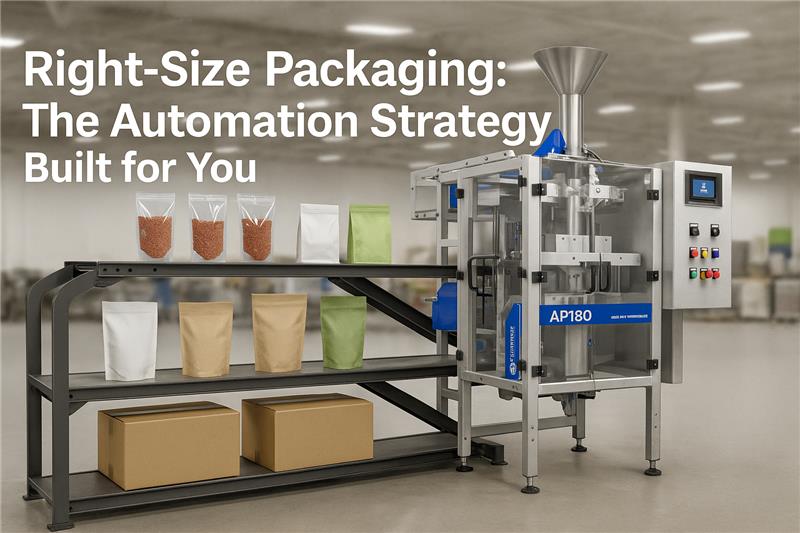Right-Sized Packaging Automation: The Packaging Strategy Built Around You

As your business grows, manual packaging hits its limits. You start exploring automation, expecting options tailored to your current needs. But most of what you find is built for someone else.
Some machines are quick to quote and easy on the budget, but they come with trade-offs in support, scalability, and longevity. Others are powerful, feature-rich systems built for much larger operations, with price tags and timelines to match.
Neither feels right because they’re not designed for your scale, your team, or your product.
You don’t need more machines than you can manage. And you shouldn’t have to settle for less than your operation deserves.
Right-Sized Packaging Automation: Why It’s Been So Hard to Find the Perfect Fit
It’s not just you. This is a gap the packaging industry has overlooked for years.
The market is built around extremes: fast-turn, low-cost equipment on one end; enterprise-scale OEM systems on the other. Both serve a purpose. But in the middle, where most growing manufacturers operate, the options are thin.
Why? Because the middle is harder to build for. It demands flexibility, engineering, service, and attention to detail without excess. That takes a different approach.
What Right-Sized Packaging Automation Looks Like?
Right-sized packaging automation is built differently. It isn’t about adding more features for the sake of complexity or chasing speed at any cost. It’s about thoughtful design, the kind that considers your product, your space, your operators, and the pace you need to run. It’s not just engineered to run; it’s engineered to run well day in and day out, in the reality of your production environment.
What does that look like?
- A machine engineered for your product and process, not retrofitted afterward.
- Interfaces, documentation, and training that feel familiar to your operators, not like learning a foreign system under pressure.
- A lead time typically 18 to 22 weeks, which is used to engineer, de-risk, and test your system before it ever ships.
- Local support, accessible parts, and a partnership that extends well beyond installation.
Because you’re not just buying automation.
You’re investing in performance, uptime, and trust.
Who Right-Sized Packaging Automation Is Built For
Right-sized packaging automation is designed for manufacturers stepping into a new phase of operational growth. If manual packaging, limited systems, or hard-to-scale equipment are holding you back, it’s time for something purpose-built for your next chapter.
You Need Automation That Aligns with Your Line, Not Just Your Industry
Off-the-shelf machines often assume your product flows like every other powder or that your bag specs follow a standard template. But your operation has real variables from product texture to pouch size. Right-sized automation is engineered to your specs, so your line runs cleanly, smoothly, and without constant adjustment.
You Need Equipment Your Operators Can Learn and Trust
In fast-moving environments, a system that only one person knows how to run becomes a liability. Right-sized machines are built to be intuitive with clean HMI screens, logical workflows, and documentation that matches how your team works. Training is delivered as part of the installation, so your staff isn’t left guessing and your line keeps moving.
You Need Reliable Support Without Long Waits or Workarounds
Downtime gets expensive fast, especially when help is in another time zone. Right-sized automation includes North American service, fast access to critical parts, and direct contact with the team that built your machine. Support isn’t outsourced or delayed. It’s built in from the start.
You Need Packaging That Keeps Pace Without Compromising Quality
Growth brings pressure. Right-sized packaging systems are designed to maintain consistency even as output increases from accurate fills to tight seals to faster changeovers. The goal isn’t just more speed. It’s production you can rely on, bag after bag.
You’re Planning Ahead, Not Just Patching What’s Broken
Short-term fixes often become long-term roadblocks: limited changeovers, inflexible tooling, machines that can’t keep up with new formats. Right-sized packaging automation is modular, upgradable, and built with scalability in mind, so your next move isn’t a full replacement.
Right-sized automation isn’t about over-engineering. It’s about designing with care for manufacturers who need flexibility, control, and dependable performance as they grow. If you’ve outgrown the extremes and are ready for something that fits your team, your goals, and your future, this is where your next step starts.
Why Unified Flex
If you’re looking for a solution that is between underbuilt and overcomplicated, Unified Flex isn’t just familiar with that space; we’ve committed our entire approach to serving it.
We engineer every system around the realities of your product and production line, not assumptions or templates. That means upfront application review, purposeful configuration, and a test process designed to eliminate surprises before your machine ever ships.
We also know that delivery isn’t the end, it’s the point where reliability matters most. That’s why we provide North American-based support, practical operator training, and documentation tailored to your team; not generic manuals pulled from a shelf.
And we stand behind every machine we deliver because we know that your packaging line isn’t just equipment. It’s your reputation, your output, and your future.
Final Thought
If packaging has become the bottleneck between where you are and where you’re trying to go, you don’t need a bigger machine; you need a better fit. If you’ve ever felt stuck choosing between a $50K machine that’s “good enough” and a $400K line that’s way too much, there’s a smarter path.
Right-sized packaging automation gives you exactly that: a system built around your product, your workflow, and your pace of growth. It’s not about spending more. It’s about investing smarter with support you can count on and performance you can trust.
Let’s build something that fits, not just technically, but strategically.
Start the conversation.